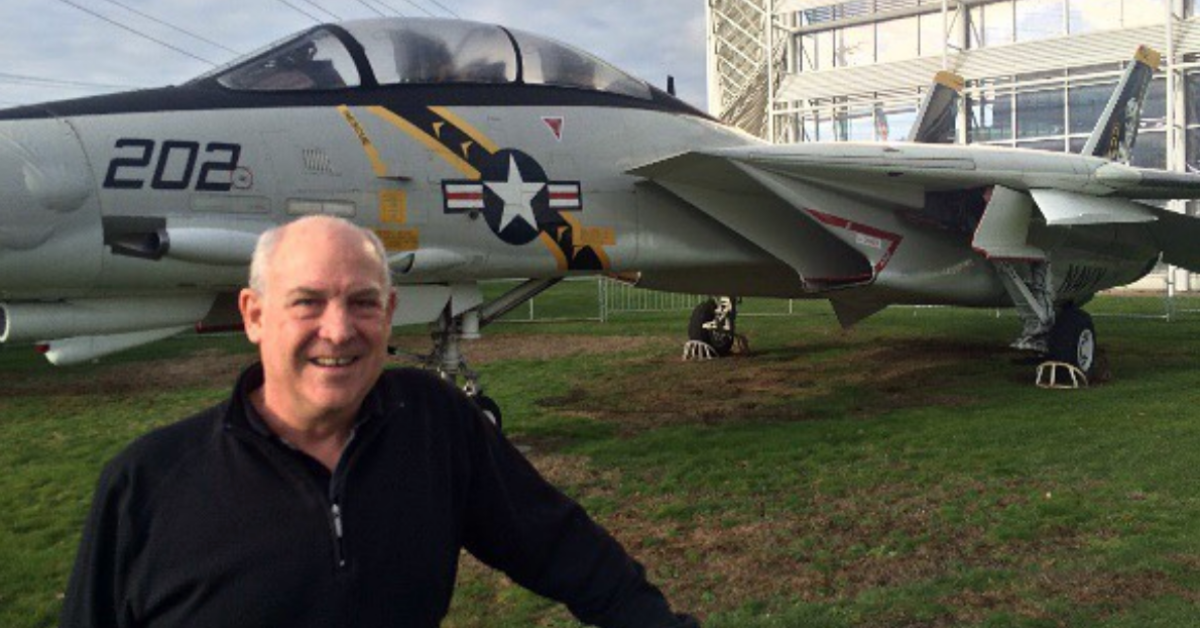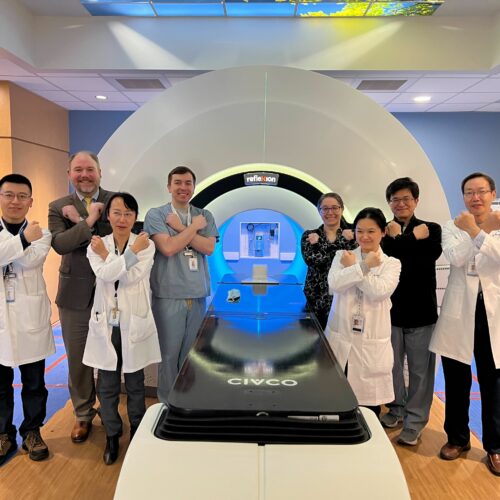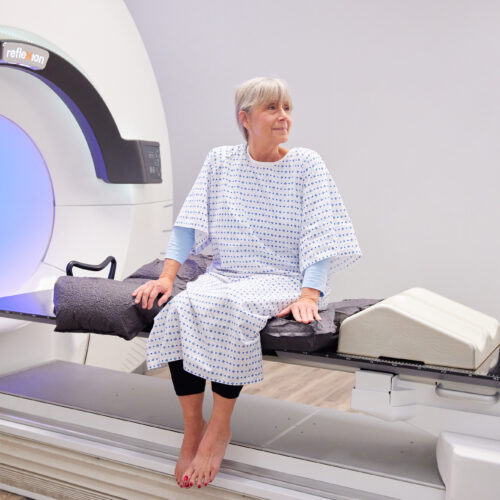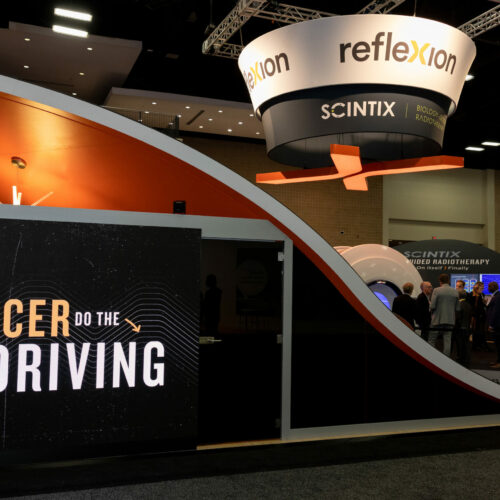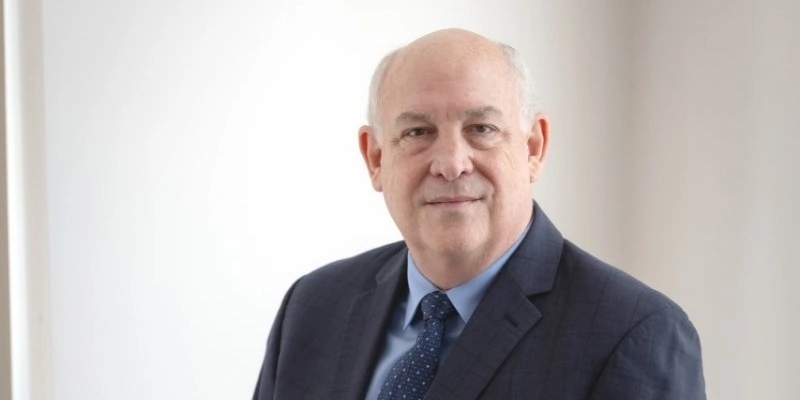
People
A ‘TOP GUN’ Battles Prostate Cancer
May 25, 2022
Michael “Bing” Crosby brings the same intensity and commitment to his fight against prostate cancer as he did to each mission as a TOP GUN naval aviator. “When you climb in the cockpit, close the canopy, and you’re all strapped in, you feel invincible,” says Crosby, a retired Navy commander who served as an F-14 radar intercept officer and created Veterans Prostate Cancer Awareness (VPCa), a nonprofit organization dedicated to educating veterans about prostate cancer screening, and active-duty military populations about the disease.
In 2015, during an annual physical and blood test, Crosby’s prostate-specific antigen (PSA) was reported as high (14.6). His subsequent biopsy indicated he had prostate cancer. Instead of retreating, Crosby looked at his diagnosis as another mission that required precision weapons. He opted for stereotactic body radiation treatment (SBRT), which included five (5) extremely accurate and high dose treatments.
At the same time, he founded VPCa to raise awareness and educate veterans about prostate cancer—the most diagnosed cancer within the VA System.1 While undergoing his initial cancer treatment, he found a lack of educational materials. “I thought, ‘Why aren’t we telling guys to go get screened earlier, to understand the difference between a screening and a procedure, and what treatment options are available?’” he says. “Men need to get screened and pay attention to their prostate. If prostate cancer is caught early, men have an almost certain chance for survival.”
In 2022, Crosby joined RefleXion Medical’s Patient Advocacy Advisory Board (PAAB) to offer guidance on prostate cancer based on his own prostate cancer journey and his advocacy work. Mike advises the company on specific needs of prostate cancer patients, with a focus on active-duty military and veterans, and the need to raise awareness about the higher incidence of prostate cancer among these populations.
Crosby still remembers vividly when Neil Armstrong landed on the moon in 1969. He was nine years old. At that mesmerizing moment, he decided he wanted to be a fighter pilot. Ironically, Crosby’s father was also a fighter pilot who died when Crosby was just four. Crosby graduated from the United States Naval Academy with a Bachelor of Science in Applied Science in 1983. In 1986, he graduated from the U.S. Navy Fighter Weapons School TOP GUN. He is also a 1988 graduate of the NATO Allied Air Forces Central Europe Tactical Leadership Program. He has a Master of Science in Systems Management from USC.
Crosby logged more than 2,700 hours in multiple tactical jet aircraft, including the F-14, F/A-18, B-1B, Mirage 2000, Tornado GR1, Harrier, F-15 and F-16N.2
During his career, Crosby logged more than 2,700 hours in multiple tactical jet aircraft, including the F-14, F/A-18, B-1B, Mirage 2000, Tornado GR1, Harrier, F-15 and F-16N.2 He switched to the US Navy Reserves in 1997 in San Diego. He flew his last flight in 1999 because the Navy had decided to start retiring the F-14 fleet. “My last flight was to Davis–Monthan Air Force Base in Tucson, Arizona, where we retired the planes,” Crosby says. “I would go back and fly today if they would let me. I still have incredible friends and lifelong relationships from my Navy career. I worked very hard at it because I enjoyed it so much.”
Crosby’s prostate cancer has returned twice since his initial diagnosis. When it returned for the first time two years after initial treatments, it had spread to his lymph nodes. He underwent treatment again, which addressed the spread to the identified lymph node involvement. The third time was in 2020, just as the pandemic began. He received treatment at the West Los Angeles VA Medical Center, where he currently receives all of his oncology care. He was enrolled in a few studies that investigated the implementation of prostate-specific membrane antigen (PSMA) radiotracer, which identifies an important biomarker found in more than 80% of men with prostate cancer.3 A PSMA scan can help determine if a person’s prostate cancer has progressed (metastasized) and where in the body it has spread.4
Using PSMA tracers and high-precision imaging, Crosby’s medical team discovered that the prostate cancer had returned to his already-treated prostate and had spread to a couple of other spots in his body. Unfortunately, his urologist couldn’t treat the recurrence in his prostate because it was too small and too close to the urethra, bladder and sphincter muscles. He had focal laser ablation on his remaining prostate tissue, followed by conventional pelvic radiation. His lymph nodes were also treated with SBRT. “This was not fun, but at the end of it, which was January 21, 2021, my PSA was essentially undetectable, and it’s still gone today. I’m at 16 months of undetectable PSA,” he says.
Radiation therapy has been a key modality for his treatment and survivorship. He opted for radiation therapy over surgery because surgery wouldn’t help treat cancer that had spread. “The radiation treatments I’ve had have always reduced the PSA testing score and bought me time. This time also allowed for other technologies to be developed to address the cancer,” he explains.
Crosby is enthusiastic about RefleXion’s biology-guided radiotherapy (BgRT)* technology, which will eventually use radiotracers, including PSMA, to guide therapy in real-time. “The more accurate the technology and its ability to target with more precision and less guesswork, the better the outcomes for patients,” he says.
“The more accurate the technology and its ability to target with more precision and less guesswork, the better the outcomes for patients.”
Michael “Bing” Crosby
CEO and President, Veterans Prostate Cancer Awareness
Crosby’s cancer journey has taught him a lot about prostate cancer. “Generally, men don’t think about it, and nobody really talks about it,” he says. “It’s the second leading cause of death in American males, and the numbers are accelerating.”
As a fighter pilot, Crosby knew he could take on any adversary and be successful. “You either wallow in your own misery and waste away, or you refocus your priorities to do what’s necessary to combat your cancer,” he says. “It’s what you do if you want to be around a little longer and you want to preserve your quality of life.”
He has known men who have struggled with the pain from late-stage prostate cancer and who receive treatment to reduce the pain. He wants to prevent as many veterans as possible from having to experience that. “I’ve always had a lot of respect for veterans that served with me and those who serve now. The work of VPCa is a way to help the men who have dedicated part of their life to the freedom of our country,” he says.
*The RefleXion® X1 is cleared for SBRT/SRS/IMRT. BgRT is pending regulatory review and is not commercially available.
References:
- S. Department of Veterans Affairs Office of Research & Development. VA Research on Cancer. 2022.
- ZERO – The End of Prostate Cancer. Mike Crosby. 2022.
- What is PSMA? November 2021.
- What is PSA and why is it important? November 2021.
Sidebar: TOP GUN
The movie Top Gun was released on May 16, 1986. According to Crosby, several aspects of the movie are accurate, including what it’s like to be a top gun fighter pilot and the need for the school. TOPGUN began in the late 1960s because the U.S. Department of Defense was unhappy with “the inferior performance of Navy F-4 Phantom crews against Soviet-made airframes in Vietnam.”1 Navy Captain Frank Ault, who headed a three-month study in 1968, recommended that ”the Navy establish an advanced fighter pilot school and create a cadre of experienced professionals to conduct the training.”1 Several months after the Ault Report was published, Naval Air Station Miramar established TOPGUN and graduated the first class the same year.1 The program known as TOPGUN was commissioned as a squadron, the Navy Fighter Weapons School, in 1972.1
“TOPGUN was developed to improve the U.S.’s performance in Vietnam. It has persisted in order to train guys to come to school and then become a weapons officer. It’s like a master’s level course in Fighter Tactics,” Crosby explains, “but there’s not a competition where you end up first in your class. You study, fly, fight, and you graduate. Some people do better or worse than others, but everyone graduates and returns to their fleet squadron to become weapons and tactics instructors. Flying fighters in the Navy is extremely competitive and every flight is a competition among your fellow aircrews. However, at the end of the competition or fight, we all must come back and land on a ship, which is graded and also competitive.”
Sidebar References:
- com. TOP GUN School. 2022.
